|
|
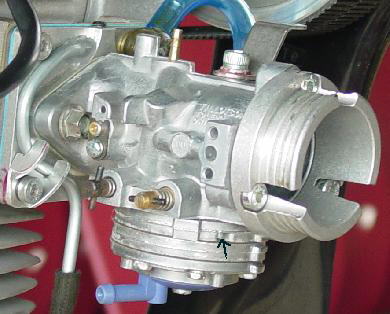 This is a view of the HR 197A carburetor and filter to carburetor adapter. By flipping the engine the low and high speed jet adjustment needles face to the front on the left side of the fuselage. This gives easier access to the high and low speed needles for adjustment and the adding of a mechanical system for adjustment from the cockpit.
This is a view of the HR 197A carburetor and filter to carburetor adapter. By flipping the engine the low and high speed jet adjustment needles face to the front on the left side of the fuselage. This gives easier access to the high and low speed needles for adjustment and the adding of a mechanical system for adjustment from the cockpit.
The arrow points out the air vent that connects to the volume below the fuel flow regulator control diaphragm. |
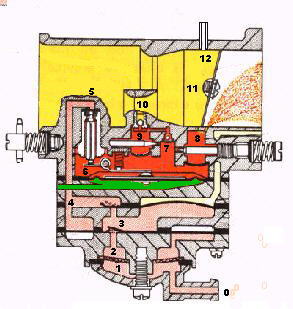
I modified a couple of the carburetor diagrams found in the Tillotson HR Manual to in- and exclude the features found in the carburetor supplied with the MZ 34. The fuel flow path is shown if one follows the numbers in increasing order. The fuel enters at zero into a bottom receiving chamber and up through a filter screen into an upper receiving chamber 2. From here it passes upward through the fuel pump inlet valve and on into the pump chamber 3. Then the fuel is forced upward through the pump outlet valve into a galleyway 4. Then the flow rises straight up and over to the needle valve inlet at 5. When fuel is withdrawn from the regulating receiving chamber 7 the spring loaded control diaphragm is pulled up and this drops the needle valve 6 to allow additional fuel to enter the chamber. Fuel is bled off from the upper receiving chamber 7 through the high and low speed jet receiving chambers 9 & 8. In this case the throttle butterfly 11 is closed, and no flow comes from the primary ventura 10 because there is insufficient pressure drop to raise the ball valve to allow the flow of fuel from the high speed receiving chamber 9. All fuel flow passes through the low speed jet into the low speed receiving chamber 8. From there the fuel flows into the bottom of the carburetor throat for idle and low speed throttle butterfly positions. Since there is no choker butterfly, a primer tap 12 provides extra fuel for starting. A push button primer is connected between this port and an unshown port to the upper receiving chamber 7. To isolate the connection between 12 & 7 a shut off valve is used. Note: One cannot prime the fuel line up to the carburetor with a standard in line squeeze bulb and/or force fuel up to the carburetor by other methods. The spring loaded fuel regulator diaphragm will not let fuel or air pass by the needle valve seat. But one can prime the carburetor with the push button primer inserted the line between 12 & 7. |
 This diagram shows full throttle open conditions. The low speed jet circuit is operating at maximum flow. Fuel is being drawn through the high speed receiving jet up past the ball valve and out through the primary ventura.
This diagram shows full throttle open conditions. The low speed jet circuit is operating at maximum flow. Fuel is being drawn through the high speed receiving jet up past the ball valve and out through the primary ventura.
The green area indicates the atmospheric vent area below the fuel flow regulator diaphragm. This is equivalent to the float bowl vent on the Bing. By controlling the pressure below the diaphragm, it may be possible to vary air fuel mixture pretty much as can be done by influencing float bowl vent pressure on the Bing 54. In my initial observations in comparing the Tillotson to the Bing, the Tillotson appears to have several advantages. The weight of the Tillotson appears to be less than the weight of a Bing 54 and Mikuni pulse pump. No vibration isolation boot is required for the Tillotson which saves additional weight. Also there is better heat transfer from the crankcase to the carburetor, and so the Tillotson may be more ice resistant. One does not have to open the carburetor or need tools or additional parts to adjust jetting. One can prime the fuel system from tank to carburetor without a fuel line squeeze bulb in between the tank and the carburetor. This saves some cost, weight and at least two fuel line connections. How it works was explained above. The Tillotson cross throttle butterfly plate is less likely to suffer wear from engine vibration in comparison to the Bing 54 vertical variable throttle slide. Mechanical in flight air fuel mixture adjustment is possible with the Tillotson. Only time will tell as to whether all of these observations prove to be true, or what other problems that may come up. |
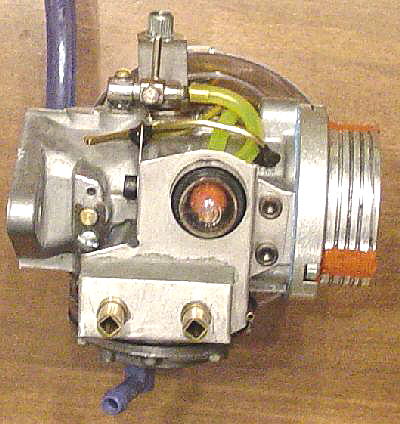 The current modified carburetor is shown to the left. The carburetor to filter adapter did not utilize a gasket at the mating surface nor did the adapter seal well to the mating filter bore. The primer port was drilled and tapped to a #10-32 thread. The boss to the left was removed so that a modified aquarium stopcock valve could be screwed into place.
The current modified carburetor is shown to the left. The carburetor to filter adapter did not utilize a gasket at the mating surface nor did the adapter seal well to the mating filter bore. The primer port was drilled and tapped to a #10-32 thread. The boss to the left was removed so that a modified aquarium stopcock valve could be screwed into place.
A bearing box assembly was mounted to enable remote low and high speed needle and jet adjustment. The primer push button was mounted in the same assembly. |
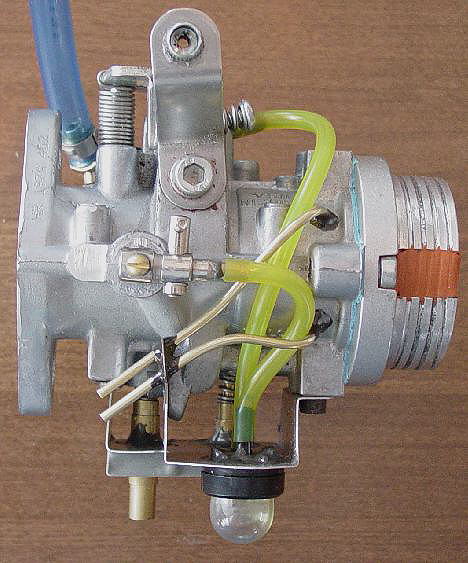 Top view. The top tube from the primer passes to the stopcock valve. The valve is necessary to ensure that excess fuel is not drawn into the engine during normal operation. The bottom tube from the primer passes to the back side to a nipple that connects to the upper receiving chamber 7.
Top view. The top tube from the primer passes to the stopcock valve. The valve is necessary to ensure that excess fuel is not drawn into the engine during normal operation. The bottom tube from the primer passes to the back side to a nipple that connects to the upper receiving chamber 7.
The two brass tubes are dynamic pressure probes that sense positive and negative dynamic pressures in the carburetor throat. Hopefully these will develop sufficient pressure difference so that it can be applied through a mixing valve to the volume below the fuel flow regulator diaphragm and control air fuel mixture (EGT). |
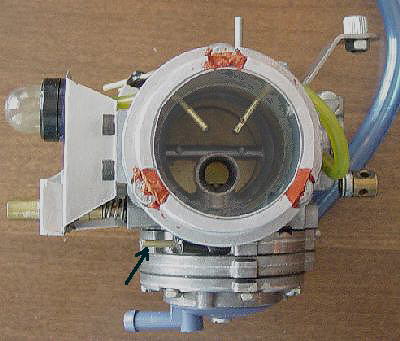 Looking into the carburetor throat one can see the positive and negative dynamic pressure sensing probes.
Looking into the carburetor throat one can see the positive and negative dynamic pressure sensing probes.
The arrow points to the new vent connection leading to the volume below the fuel flow regulator diaphragm. The bearing box and push button primer mounts were made from folded 0.020 inch thick aluminum. The primer push button, part # 20-11510, can be purchased from mfgsupply. |
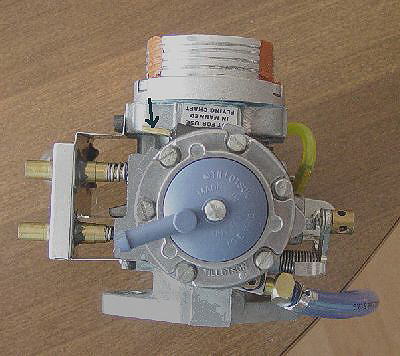 The bottom view. Again the arrow points to the vent from below the fuel flow regulator diaphragm.
The bottom view. Again the arrow points to the vent from below the fuel flow regulator diaphragm.
This gives the best view of the bearing box assembly to support the mechanical means to adjust the high and low speed jets from the cockpit. |
Adding Static Pressure Port & Heater 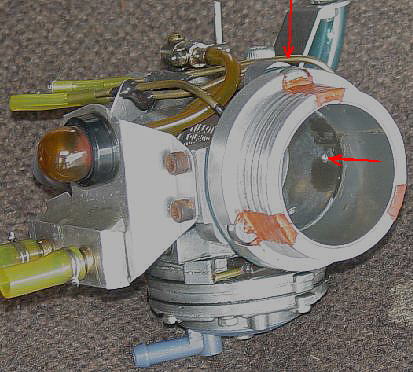 A hole was drilled to enable sensing the static pressure in the carburetor inlet. This will allow pressure drop measurement across the air filter. Also it can be used to determine the best point to take incoming air to run the highest carburetor inlet air pressure for the best engine performance.
A hole was drilled to enable sensing the static pressure in the carburetor inlet. This will allow pressure drop measurement across the air filter. Also it can be used to determine the best point to take incoming air to run the highest carburetor inlet air pressure for the best engine performance.
The horizontal red arrow points the static pressure sensing hole, and the vertical arrow points to the connecting brass tube. |
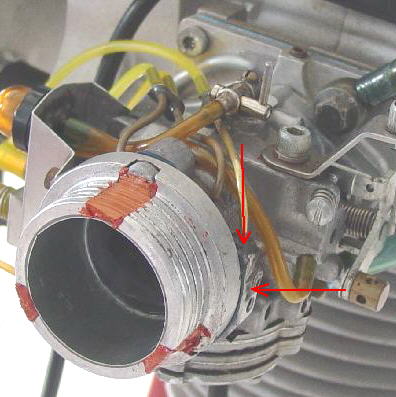 Another view to show the static port hole locations. The hole into the carburetor throat was drilled through a boss found on the back side of the carburetor. A connecting vertical hole was drilled down from the top. The tube was inserted and every thing was sealed and fixed into place with JB Weld.
Another view to show the static port hole locations. The hole into the carburetor throat was drilled through a boss found on the back side of the carburetor. A connecting vertical hole was drilled down from the top. The tube was inserted and every thing was sealed and fixed into place with JB Weld.
|
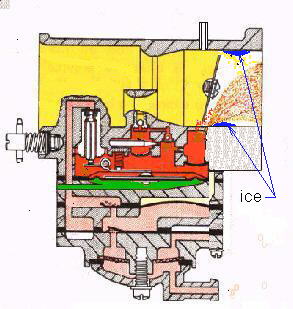 The diagram to the left illustrates low speed engine operation. The butterfly is almost closed with air passing over the top and the bottom with fuel mixed with the air on the bottom. As the butterfly moves from wide open toward the closed position, the air pressure drop across the butterfly increases and reaches a maximum at the idle position. As the air expands on the down wind side of the throttle plate, the air temperature drops. If the air is carrying along moisture (high humidity} it will condense out just aft of the butterfly. If the free air temperature is low and the pressure drop high enough, the moisture will be super cooled and it will start to freeze on the top and the bottom throat surfaces.
The diagram to the left illustrates low speed engine operation. The butterfly is almost closed with air passing over the top and the bottom with fuel mixed with the air on the bottom. As the butterfly moves from wide open toward the closed position, the air pressure drop across the butterfly increases and reaches a maximum at the idle position. As the air expands on the down wind side of the throttle plate, the air temperature drops. If the air is carrying along moisture (high humidity} it will condense out just aft of the butterfly. If the free air temperature is low and the pressure drop high enough, the moisture will be super cooled and it will start to freeze on the top and the bottom throat surfaces.
If this condition is maintained for a long period, such as, let down from altitude, approach and landing, the ice can grow to the point that it interferes with the fuel flowing from the low speed jets and the engine will starve for fuel and quit. |
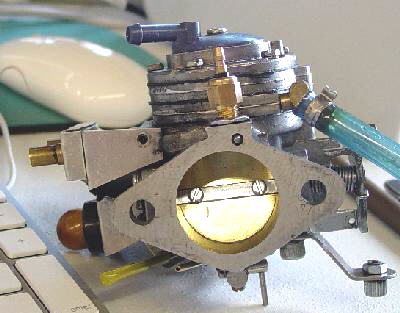 Carburetors used on some motorcycle and atv engines utilize stud bolt heaters keep the ice from forming during low engine speed operation. The trick is to place the heat source where the ice can interfere with the low speed fuel ports.
Carburetors used on some motorcycle and atv engines utilize stud bolt heaters keep the ice from forming during low engine speed operation. The trick is to place the heat source where the ice can interfere with the low speed fuel ports.
I searched the web and found a small stud bolt heater that is used on carburetors for KTM motorcycles. The flat boss on the bottom of the carburetor was drilled and tapped to accept the heater thread. The hole passes though a plugged drill galley. Due to this intrusion, one must be careful to blow all chips out of the low speed side of the carburetor. JB Weld was used to seal the threads and to lock the heater in place. |
 An oak insulating cuff was made to cover the exposed part of the heater from the free air. It is held in place with JB Weld. This ensures that most of the heat ends up in the material that surrounds the slow speed fuel ports.
An oak insulating cuff was made to cover the exposed part of the heater from the free air. It is held in place with JB Weld. This ensures that most of the heat ends up in the material that surrounds the slow speed fuel ports.
To activate the heater a wire runs to the cockpit were a switch connects it to the power system. Next Spring I will get a chance to test it out. Hopefully there will be no more engine quits on final. |